

Full Paper



| Full Paper |

|
A Computer-Guided Diagnosis System for Transfusion Medicine Laboratories
Robert A Dunstan*, Robyn Devenish* and Rodney Kevill
idunstan@info.curtin.edu.au and r.kevill@info.curtin.edu.au
*School of Biomedical Sciences and Academic Computing Services
Curtin University of Technology
Abstract
Medical Scientists working in Transfusion Medicine laboratories (blood banks) perform blood grouping and compatibility testing on patient and donor blood. The ability to correctly resolve serological problems arising out of this testing is an essential skill and errors can be life-threatening to the patient. Teaching has historically involved the use of simulated case studies in tutorial and laboratory sessions and is a valuable way of integrating the students theoretical and practical knowledge. However these activities are limited by the availability of suitable clinical material, the limited formal contact time available and by large class sizes. The aim of this CAUT-funded project is to produce an innovative computer-guided diagnosis system which will develop investigative skills by the use of realistic case studies without the need to handle blood specimens. The computer-guided case studies will serve as an adjunct to the tutorial and laboratory sessions. This program will allow the student to access relevant patient history, previous laboratory results and in some cases, images of blood films. They will be able to seek immediate on-screen tutorial help, correct mistakes, decide on appropriate further testing and see the results of that testing. Development of the prototype case study will facilitate the rapid development of a number of case studies of varying degrees of difficulty and complexity.
Key Words
Transfusion medicine, case studies, interactive, multimedia, computer, learning, CAUT.
Introduction
This unique project will produce a self-paced computer-guided diagnosis system containing a series of case studies involving the resolution of serological problems in Transfusion Medicine. It will provide the Medical Science student the opportunity to simulate a testing protocol as an integrated case study with review and/or help modes, but without the need for access to clinical material, laboratory reagents and facilities and to tutors for information and assistance.
Each case will include details of clinical information, laboratory results and in some cases, captured microscopic images of blood films. The student will decide on appropriate additional tests to be performed and be able to see the results of those tests. To further reflect the demands of the working environment, restrictions on testing time and testing costs will be incorporated into some versions of case studies. Tutorial guidance material will be available with information on test procedures, normal ranges, significance of results and the resolution of the problem.
A number of case studies will be compiled for this project varying in complexity from simple straight-forward examples to complicated investigations. Personal floppy discs and access numbers will be used to monitor progress and students will be able to select the level of difficulty of a case study.
Improvement and Impact on Teaching
This project should improve student learning outcomes, rationalize laboratory and tutor availability problems, advance teaching practice as well as confer other advantages.
The completed package should lead to practical advances in teaching, learning and assessment in this field of study by providing for the first time, a totally new approach to teaching Transfusion Medicine laboratory practise using an interactive package with tutorial help available on demand.
Advantages over current teaching practice:
Future developments for this package will be to expand the number of case studies and to test national and perhaps international demand for these programs. The project reference group have indicated that this package would be valuable in the workplace for training and continuing education. The Australian Society of Blood Transfusion in association with the Royal College Pathologists of Australia and the National Association of Testing Authorities conduct frequent quality reviews on a national basis to over 400 laboratories by mailing of blood samples. Possible use of this package as an alternative approach to quality assurance surveys will be examined.
Monitoring and Evaluation Process
The development of the program, case studies and strategies are being evaluated throughout this project. Other stages of review / evaluation are indicated in timetable.
In August 1995, a survey of second and third year undergraduate students was implemented to ascertain perceived problems and difficulties in the current approach to transfusion case study teaching at Curtin. Significant findings have been incorporated into the authoring system.
Each completed case study will be evaluated by students and a reference group.
The user interface, graphics, and navigation tools have been regularly reviewed by the project group and student participants to evaluate "user-friendliness".
Evaluations and student surveys to be performed by multi-question check sheet seeking comments and approval/disapproval ratings.
In addition to the project personnel already listed above, a project Reference group will be used. The project reference group includes the two most influential scientists in Transfusion Medicine in Western Australia. They have been chosen for their expertise and experience and their current involvement with educational and quality assurance programs.
The role of this group will be to provide advice on the development of the package and the relevance and correctness of interactive aspects . They will review the teaching materials, diagnostic protocols and results. They have also offered to provide access to case study material.
Integration
When completed this project will be integrated into existing University undergraduate and post-graduate courses in Medical/Biomedical Sciences - particularly in units relating to Transfusion Medicine. This package could be linked with the Blood Cells package for some case studies to provide a most comprehensive Haematology/Transfusion Medicine system. Other case studies would operate as a free-standing module. In excess of 90 students currently study Transfusion Medicine in undergraduate courses. Each case study will be developed from current laboratory practical manuals and supplementary lecture notes developed by the project leader.
The implementation of the project into current courses would be carried out through the appropriate Subject Committees at the University.
Curtin University has given strong support through the School of Biomedical Sciences for the current project by the provision of work space to house the project, secretarial support, office facilities, instructional technology hardware and appropriate computer software and hardware.
The Development Team
To undertake the development a project committee was established under a Project Leader whose role was to supervise all aspects of case study development and determine suitability of instructional design. He was also responsible for organizing course integration as well as the evaluation procedures. The individual concerned (RAD) has extensive experience in course design, implementation and coordination and has produced many manuals and teaching materials.
An Instructional Designer/Programmer from Academic Computing Services at Curtin University was responsible for programming. The individual concerned (RK) has a degree in computing, expertise in developing, trialling, monitoring and assessment of instructional modules and the use of the Supercard language.
A Medical Scientist, Multimedia Consultant and Lecturer in Haematology at Curtin University was given the role of Project Manager. She has 15 years experience as a Senior Medical Scientist in major teaching hospitals and significant practical expertise in all aspects of diagnostic Transfusion Medicine. She (RD) has participated in an Interactive Multimedia Workshop funded by DEET and is familiar with all computer tools required to construct multimedia packages. Her role is to assist the Project Leader to prepare drafts of instructional modules and screen layouts. She will collect images from blood films and conduct evaluations
The Project Manager and the Instructional Designer both have experience in two other CAUT-funded projects in a related area and their experience has been invaluable in this project.
A Graphic Designer/Consultant was employed for the design and preparation of screen layouts.
Program Design and Structure
The project was developed in Supercard 2.5, an environment very similar to Hypercard, but with the addition of built-in 8-bit (256) colour and the facility to add scripts to graphic objects. The scripting language SuperTalk is a super-set of HyperTalk, and the conversion of Hypercard stacks to Supercard stacks is provided within Supercard. Some minor "tweaking" may be necessary with some Hypercard commands which are not directly supported in Supercard.
Supercard also provides an Internet Browser plug-in called Roadster which enables Netscape Navigator to download and view Supercard projects from the World Wide Web. This aspect is currently being investigated as a possible solution to cross-platform delivery.
The main modules of the Blood Bank program are essentially data-driven. It is designed as a series of template screens on which different images and data relating to each case study is presented to the student. The selection of the particular case study may be decided by the student or may be selected, either sequentially or randomly, by the program itself, depending on the mode and difficulty level required.
An important part of the design is to enable the program to be used in an intuitive "author" mode to enable the subject expert to generate or modify and save case study data without the necessity for a programmer. During the "authoring" process, the program may be switched to "student" mode to provide an immediate check from the student perspective. The main advantages of the author mode is that additional case studies may be created without technical programming assistance, and case study data may be verified and/or modified while the subject expert works through the program.
An initial storyboard was created on paper with as many facets of the logic design included as was possible in the early stages. From this design, elements of the storyboard were prototyped in Supercard and the data structures were created. The data structures consisted of two main parts: data that was common to the whole project and data that was unique to each case study. Graphics were created later in the process and gradually replaced the more simplistic "draw" objects of the initial prototype.
Navigation was considered to be critical in this project. A "cumulative" Back button is provided which back-steps through every screen visited by the student, an intuitive "map" screen shows a hierarchical layout of the various modules and includes hot-links to individual screens, and navigation buttons appear in context with the path taken by the student through the screens. In addition, tutorials are provided and on-line help is available throughout the program.
The overall program design is basically quite simple, but the interactions occurring on some individual screens is logically very complex. Responses from a student's action vary greatly, depending on the path the student may have followed through the blood-matching process and the particular case being investigated.
The Student View
Initially, students select from a range of case studies from basic to advanced. At this stage of development, tutorial mode only is offered, but future options will include an assessment mode.
The first screen in each case study (Figure 1) is a request form based on that used in local hospitals. The layout and appearance of all forms used in the program were specifically designed to simulate as accurately as possible actual forms used in current practice.
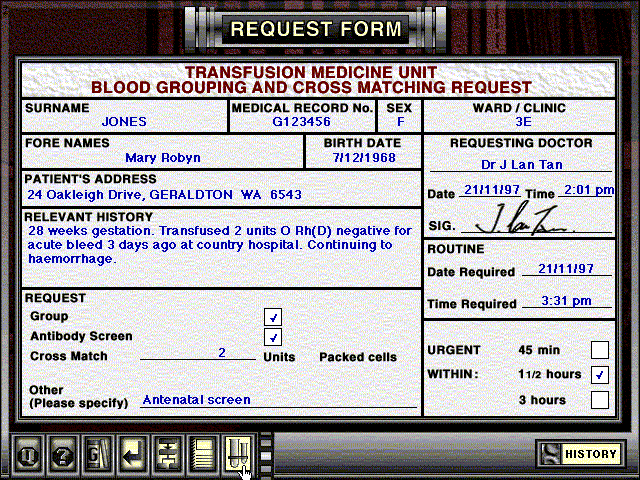
Figure 1: The Request Form
The request form contains a patient Medical Record number which is of critical importance in identifying the patient and accessing results throughout the tutorial. The current date and time from the computer are used to provide a "real time" constraint to the tutorial environment.
From this screen, students have the opportunity to view further case history information by clicking the "History" button.
They then move to a "Select a Test" screen where they choose a test procedure from a range of eight broad categories of blood bank tests (Figure 2).
In this case, the student chooses Blood Grouping to begin their procedure, and then chooses from a number of blood groups offered in the Blood Grouping screen (Figure 3).
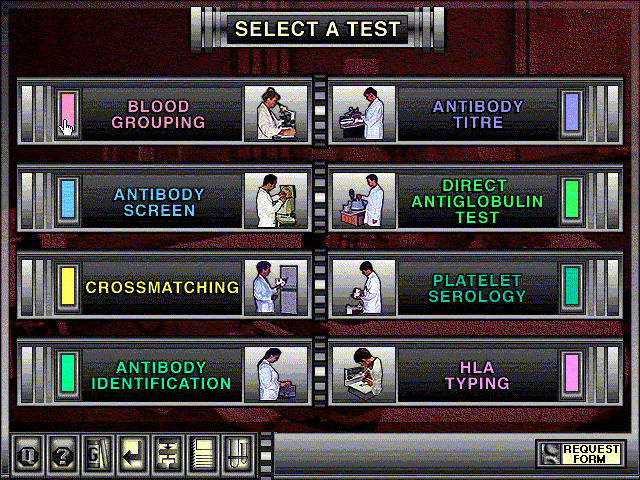
Figure 2: The "Select a Test" Screen
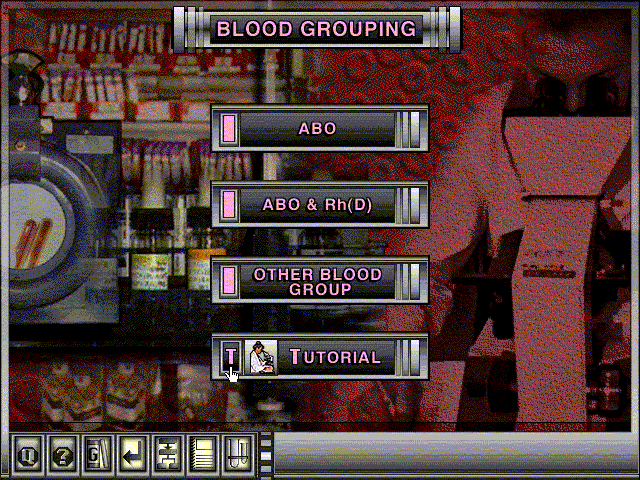
Figure 3: Blood Group selections
This screen (and others at a similar level) provide a "Tutorial Help" button which takes the student to screens which provide background information and assistance with choices related the screen containing the button (Figure 4). There is also case-specific tutorial information available for interpretation of test results.
If the student chooses ABO and Rhesus Blood Group for example, they are then required to enter the patient Medical Record number. If this is entered correctly they will be given a set of results for that test and also the results of control samples (Figure 5).
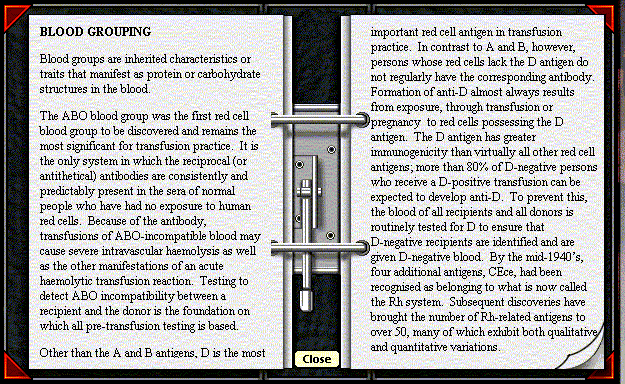
Figure 4: Tutorial Help screen for Blood Grouping
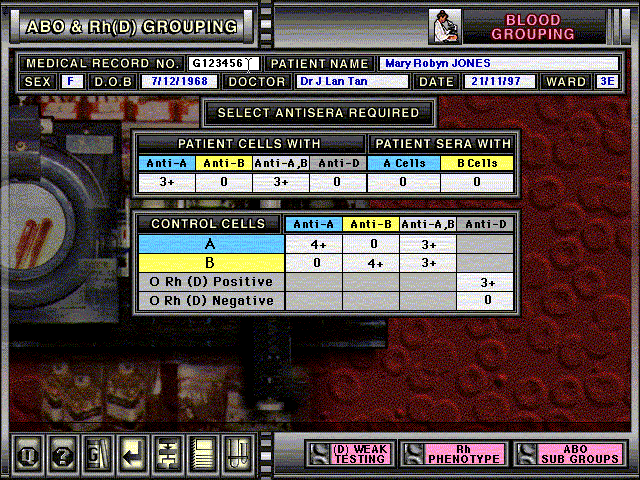
Figure 5: Patient results for ABO and Rh(D) Grouping Students can call up a "floating" notebook and enter results and comments at any time during the investigation (Figure 6). They may also return to the Request Form to verify patient information. If the student chooses "Antibody Identification" for example, from the "Select a Test" screen, they are again required to enter the patient Medical Record number. If this is entered correctly they will be given a set of results for that test. Here a moving panel is used to determine possible antibody matches (Figure 7). These must all be correct before the student progresses further.
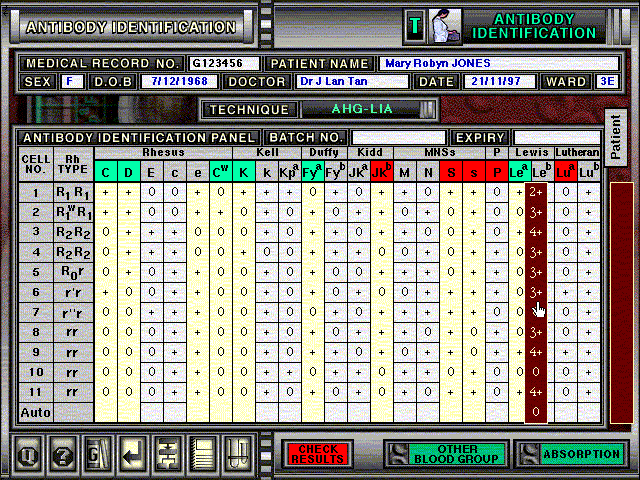
Figure 7: The Antibody Identification panel As with the request form, this screen is modeled on the paper data sheets used on a daily basis in blood banks. At the end of the case study, students complete a report form from their observations and notebook results. This may consist of a list of all the test results as well as blood units suitable for transfusion to the patient. The Future
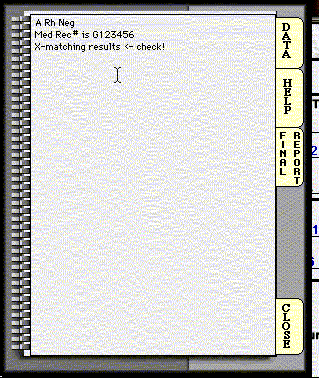
Figure 6: The "floating" notebook For the Medical Science student studying transfusion medicine, it is difficult to appreciate the interaction between the laboratory procedures and other areas of blood bank practise and, most importantly, the errors that may occur in this stressful environment. It is proposed to develop a computer-based Virtual Blood Bank so that students can better appreciate this integration of the various areas. These areas include the laboratory testing; maintenance of records on patients and blood supply/usage; blood and blood component ordering, storage, inventory and dispensing; quality assurance. A request for a transfusion may involve the Scientist in all of these areas. The student will be able to move around the Virtual Blood Bank, select blood from refrigerators, operate items of equipment, enter data into a computer, etc, all with on-screen help available on demand. This exciting new and unique approach to learning in transfusion medicine will better prepare the student for assimilation into the workplace. It is also proposed to develop an animation component for interactive learning of laboratory methodology. A further animation component will be designed to enable students more easily and rapidly to master the necessary skills in reading laboratory results. These animation components will also be incorporated as learning options in the case studies developed from the 1996 project. The case studies described here will ultimately be integrated into the Virtual Blood Bank project. A testing/assessment version of the case studies will be developed. It is also intended to increase this library of case studies and to undertake extensive student and staff evaluation of the program Australia-wide and Internationally. Ultimately, it is intended to develop this project in three directions: to expand the number of case studies; to adapt the package for assessment purposes; to test national and international demand for this package in Transfusion Medicine courses. Discussions of this project with colleagues in the Eastern States and in the USA has indicated a great deal of interest and elicited requests to be involved with trialling of the prototypes. The project reference group have also indicated that this package would be valuable in the workplace for training and continuing education.

This page maintained by Rod Kevill. (Last updated: Friday, 21 November 1997)
NOTE: The page was created by an automated process from the emailed paper and may vary slightly in formatting and layout from the author's original.